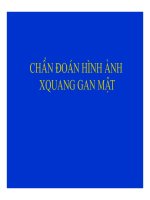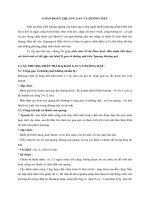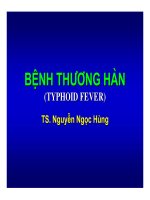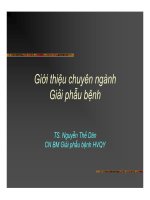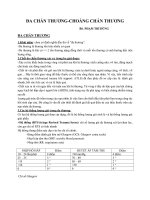ASM1 IOT MERIT BTEC FPT
Bạn đang xem bản rút gọn của tài liệu. Xem và tải ngay bản đầy đủ của tài liệu tại đây (2.88 MB, 45 trang )
ASSIGNMENT 1 FRONT SHEET
Qualification BTEC Level 5 HND Diploma in Computing
Unit number and title
Submission date Unit 43: Internet of Things
Re-submission Date
Student Name 21/10/2023 Date Received 1st submission 21/10/2023
BD00196
Date Received 2nd submission
Nguyen Thanh Tai Student ID
Class IT05202 Assessor name Truong Dang Hieu
Student declaration
I certify that the assignment submission is entirely my own work and I fully understand the consequences of plagiarism. I understand that
making a false declaration is a form of malpractice.
Student’s signature
Grading grid P2 M1 M2 D1
P1 Page | 1
Summative Feedback: Resubmission Feedback:
Grade: Assessor Signature: Date:
Internal Verifier’s Comments:
Signature & Date:
Page | 2
TABLE OF CONTENT
Contents
TABLE OF CONTENT ..................................................................................................................................3
LIST OF TABLES .........................................................................................................................................5
LIST OF FIGURE .........................................................................................................................................6
LIST OF THE ACRONYM .............................................................................................................................7
INTRODUCTION ........................................................................................................................................8
LO1 : Analyse what aspects of IoT are necessary and appropriate when designing IoT system on
electronic platform ...................................................................................................................................9
1. Explore various forms of IoT func onality on electronic pla orm (P1). .........................................9
1.1 What is Internet of Things..........................................................................................................9
1.2 History of Internet of Things ....................................................................................................11
1.3 Characteris cs of Internet of Things ........................................................................................13
1.4 Why use Internet of Things ......................................................................................................14
1.5 Applica on of Internet of Things .............................................................................................15
2. Review standard architecture, frameworks, tools, hardware and APIs available for use in IoT
development.(P2) ............................................................................................................................... 17
2.1 Architecture of IOT ...................................................................................................................17
2.2 Frameworks of IoT....................................................................................................................19
2.3 Describe how Arduino/Raspberry Pi board and end device. ...................................................21
2.4 Sensor .......................................................................................................................................23
2.5 API for use in IOT development ...............................................................................................27
3. Evaluate the impact of common IoT architecture, frameworks, tools, hardware and APIs in the
so ware development lifecycle.(M1) ................................................................................................29
3.1 Evaluate the impact of architecture, framework, tools, hardware and API in the life cycle of
student IOT applica on development. ..........................................................................................29
3.2 How to apply 2 or 3-layer architecture ....................................................................................30
3.3 Is the API faster? What support tools? (For example, in the IOT tree problem combining
sensors and ming APIs) ................................................................................................................32
4. Review specific forms of IoT architecture, frameworks, tools, hardware and APIs for different
problem-solving requirements.(M2)..................................................................................................33
5. Evaluate specific forms of IoT architecture and jus fy their use when designing so ware
applica ons.(D1) ................................................................................................................................38
CONCLUSION ..........................................................................................................................................43
CRITICAL EVALUATION............................................................................................................................44
Page | 3
REFERENCES............................................................................................................................................ 45
Page | 4
LIST OF TABLES
Page | 5
LIST OF FIGURE
Figure 0.1: Internet of Things(IOT).......................................................................................................... 9
Figure 0.2: History of IOT. ..................................................................................................................... 12
Figure 0.3: Characteris cs of IOT. ......................................................................................................... 13
Figure 0.4: Benefits of IOT..................................................................................................................... 15
Figure 0.5: Applica on of IOT................................................................................................................ 17
Figure 0.6: Architecture of IOT.............................................................................................................. 19
Figure 0.7: Framework of IOT. .............................................................................................................. 21
Figure 0.8: Example some end device................................................................................................... 23
Figure 0.9: Light Sensor Circuit.............................................................................................................. 24
Figure 0.10: Temperature Sensor Circuit. ............................................................................................. 25
Figure 0.11: Mo on Sensor................................................................................................................... 25
Figure 0.12: Humidity Sensor. ............................................................................................................... 26
Figure 0.13: Sound Sensor..................................................................................................................... 27
Figure 0.14: API. .................................................................................................................................... 29
Figure 0.15: Layer-Architecture. ........................................................................................................... 31
Figure 0.16: Ring Company (h ps://ring.com/).................................................................................... 39
Figure 0.17: Survey................................................................................................................................ 41
Page | 6
IoT LIST OF THE ACRONYM
IoTaaS
API Internet of Things
GPS Internet of Things as a Service
Application Programming Interface
Global Positioning System
Page | 7
INTRODUCTION
Not long ago, the concept of the Internet of Things (IoT) became a familiar part of our daily lives. IoT
represents the connec on of billions of devices, sensors and informa on systems over the Internet,
allowing them to exchange informa on and perform tasks that previously seemed impossible. The
subject of IoT is not only an important step forward in technology development, but also an
opportunity for us to understand how to connect devices and applica ons together to create a smart
and convenient world. . In this course, we will explore the fundamental aspects of IoT, from sensors
and connec vity to data analy cs and prac cal applica ons. We will see that IoT is not just a new
field of technology but also an opportunity to create innova ve and exci ng solu ons for the real
world.
IoT has changed the way we interact with our surroundings and brought many benefits in many
fields, from industry, agriculture, healthcare to smart homes and the world of technology. In this
course, we will learn how to build IoT systems, become familiar with the tools and techniques
needed to develop IoT applica ons, and understand how IoT projects can help solve real-world
problems. interna onal. Let's enter the world of IoT together and explore its endless poten al to
create future advancement and innova on.
At the heart of my role is the exci ng challenge of envisioning, planning and developing IoT products,
services and applica ons tailored to our customers' unique needs. Under the guidance of my astute
manager, I embarked on a thrilling journey to create a groundbreaking IoT solu on for a poten al
client.
And below is an ar cle where I briefly learned about IoT:
LO1 Analyze what aspects of IoT are necessary and appropriate when designing so ware
applica ons.
Page | 8
LO1 : Analyse what aspects of IoT are necessary and appropriate when
designing IoT system on electronic platform
1. Explore various forms of IoT func onality on electronic pla orm (P1).
1.1 What is Internet of Things.
The Internet of Things (IoT) is a technology concept in which smart gadgets and things are linked to
the internet to interact, gather data, and execute ac vi es across a network. This enables gadgets to
func on independently, share informa on, and interact with the environment and humans.
Figure 0.1: Internet of Things(IOT).
The fundamental elements of IoT encompass :
Devices/Things: These are physical items or sensors integrated with various technologies for data
collection and transmission. Simple sensors to complicated gadgets are examples.
connection: The Internet of Things (IoT) relies on numerous connection technologies to allow objects to
interact with one another and with central systems. Wi-Fi, cellular networks, Bluetooth, Zigbee, LoRa,
and other common networking methods are available.
Page | 9
Data Processing: In order to derive relevant insights from the data generated by IoT devices, it must be
processed. Data storage, data analytics, and data processing technologies are all involved.
IoT systems frequently rely on cloud computing services to store and handle massive volumes of data
generated by IoT devices. Scalability, accessibility, and security are all advantages of cloud systems.
Sensors and Actuators: These are critical components that enable devices to perceive their surroundings
and take action. Sensors gather data, whereas actuators allow equipment to respond to data by taking
action.
IoT networks allow data to be sent between devices and central systems. These networks can be local
(for example, LAN) or wide-area (for example, the internet). Edge computing may be used in IoT
networks to minimize latency.
IoT security is critical for protecting data and devices from cyber attacks. Encryption, authentication, and
access control are examples of security mechanisms.
User Interface: The Internet of Things frequently includes interfaces that allow people to engage with
devices and systems. Mobile applications, web dashboards, and other user-friendly technologies can be
used as interfaces.
Analytics and Insights: IoT provides a plethora of data, which is utilized by analytics tools to draw
insights, make predictions, and improve operations.
Data Storage: IoT data must be effectively and securely stored. This might be in databases, data lakes, or
other types of storage systems.
Control and Automation: The Internet of Things enables remote control and automation of objects and
systems, increasing efficiency and convenience.
Scalability: As more devices are added and more data is collected, IoT systems must be built to grow.
Page | 10
1.2 History of Internet of Things
The Internet of Things concept emerged in the late 1990s, but has evolved fast since the beginning of
the twenty-first century as wireless technology, sensors, and internet connec ons have become
more prevalent. The development of wireless networking protocols such as Wi-Fi and Bluetooth, the
prolifera on of embedded sensors, and the advent of IoT applica ons in fields such as industry,
healthcare, healthy living, and smart families are all significant occurrences.
The no on of connec ng devices and things to the Internet and allowing them to gather and
exchange data for a number of reasons may be traced back to the Internet of Things (IoT). Here is a
quick rundown of key moments in the history of IoT:
Early Concepts (Late 20th Century): The idea of connec ng objects to the internet began to
emerge in the late 20th century. One of the earliest examples was Carnegie Mellon
University's "Coke Machine" in the early in the 1980s, was one of the first devices connected
to the Internet. It allows users to check the status of the so drink vending machine and see
if their favorite drinks are available.
RFID technology (1990s): Radio frequency iden fica on (RFID) technology played an
important role in the development of IoT. RFID tags allow objects to be uniquely iden fied
and tracked.
IPv6 (Late 1990s): The adop on of IPv6, which provides a greatly expanded address space,
has become an important development for IoT. It allows an almost unlimited number of
devices to be connected to the Internet.
Wireless Sensor Networks (WSN) (Early 2000s): Wireless sensor networks, consis ng of small,
low-power sensors that can communicate wirelessly, laid the founda on for IoT. These
sensors are used in a variety of applica ons, including environmental monitoring.
Smart Home (Mid-2000s): The concept of the smart home emerged, with companies like Nest
introducing connected thermostats and smoke detectors. This marked the beginning of
consumer-facing IoT applica ons.
Industrial IoT (IIoT) (Late 2000s): Industry began adop ng IoT for remote monitoring and
predic ve maintenance of machinery. IIoT plays a vital role in improving efficiency and
reducing down me in industrial processes.
Page | 11
IoT standards (2010s): Various organiza ons and alliances began working on IoT standards
and protocols to ensure interoperability and security. Examples include the IoT Consor um
(IoTC), the Open Connec vity Founda on (OCF), and the Industrial Internet Consor um (IIC).
The rise of wearables (2010s): The growth and adop on of wearables, such as fitness trackers
and smartwatches, has expanded the scope of IoT to include health monitoring. personal
health and fitness.
5G connec vity (2020s): 5G network deployment promises to deliver faster and more reliable
connec vity, enabling IoT applica ons that require low latency and high bandwidth.
Edge Compu ng (Ongoing): Edge compu ng has become an integral part of IoT, allowing data
to be processed closer to the source, reducing latency and improving real- me decision
making.
The history of IoT is con nually changing, with new applica ons and advancements appearing
in a number of industries such as smart ci es, agriculture, healthcare, and autonomous cars.
The future of IoT promises even more linked gadgets and a growing influence on how we live
and work.
Figure 0.2: History of IOT.
Page | 12
1.3 Characteris cs of Internet of Things
The Internet of Things (IoT) is a network that connects physical gadgets, cars, buildings, and other items.
Sensors, software, and communication capabilities are incorporated in these items to ease data gathering and
interchange. While IoT technology is continuously evolving, certain common characteristics identify it:
Connectivity: The Internet of Things allows devices to connect to the internet or to one another via a
network.
Sensors and data collection: IoT devices are frequently outfitted with sensors that allow them to gather
data from their surroundings.
Integration and automation: IoT aids in the integration of devices and the automation of operations.
Remote management refers to the ability to manage and control equipment through the internet.
Data analytics and artificial intelligence: Process and analyze IoT data to provide relevant information
and make sound decisions.
These features describe the essence of IoT technology, which has applications in a variety of industries
such as healthcare, agriculture, transportation, manufacturing, smart cities, and others.
Figure 0.3: Characteris cs of IOT.
There are many important characteristics of IoT (Internet of Things), but here are three main ones:
Very Large Scale: IoT is a large system, connecting billions of devices and sensors worldwide. The
dramatic increase in scale requires solutions and network infrastructure that not all technologies are
capable of handling.
Page | 13
Heterogeneity: IoT requires integration between many different types of devices, sensors, protocols
and platforms. This poses a big challenge in the management and interaction between different
components of the IoT system. This diversity includes sensors for temperature, humidity, light, moving
objects, embedded computers, personal computers, and many other connectivity platforms.
Pervasivity: IoT pervades our daily lives and surroundings. From smart home systems, autonomous
vehicles, energy management, to water management and healthcare, IoT is present in every area of life.
This inclusivity ensures that IoT is changing the way we interact with the world around us.
These specialties create IoT independence and lay down significant formulas and foundations in the
development and deployment of IoT applications.
1.4 Why use Internet of Things
The Internet of Things (IoT) brings many important benefits and has a significant impact in many aspects of
life and industry. Here are some important benefits of IoT:
Optimize performance and save costs: IoT enables process automation and real-time data collection
from devices and sensors, helping to optimize operations and reduce waste.
Data collection and intelligent analysis: IoT provides data from billions of devices for analysis, helping
companies and organizations make data-driven decisions and generate useful information.
Smart Industrial Manufacturing (Industry 4.0): IoT has transformed the way manufacturing and supply
chains are managed, helping to create smart factories with data-based management, prediction and
automation.
Predictive maintenance and repair: IoT allows monitoring the health of industrial equipment and
machinery, predicting when they need maintenance or repair before they break down.
Smart products and services: IoT enables the development of smart products and services, including
smart home appliances, autonomous vehicles, smart medical devices, and many other applications.
Enhance user experience: IoT provides convenience and better user experience through applications
such as smart home, smart city, and smart security systems.
Asset and transportation management: IoT helps track location and manage assets, goods, and
transportation more effectively.
Clean Energy Production: IoT assists in optimizing renewable energy production and managing energy
consumption.
Health and healthcare: IoT provides remote health monitoring, smart medical devices, and medical
data management systems.
Environmental protection: IoT helps monitor and protect the environment through atmospheric,
Page | 14
water, and forest monitoring applications.
These benefits have changed the way we live and work, and the potential of IoT is still opening up
new opportunities for progress and innovation. However, security and privacy issues also need to be
considered during IoT deployment.
Figure 0.4: Benefits of IOT.
1.5 Applica on of Internet of Things
The Internet of Things (IoT) has a wide range of applica ons across various industries. Here are some
common applica ons of IoT:
Smart Home: IoT is widely used in smart home systems to control ligh ng, hea ng, security,
and appliances. Examples include smart thermostats, smart ligh ng, and voice-controlled
virtual assistants.
Smart Ci es: IoT is used to improve urban infrastructure and services, such as smart traffic
management, waste management, air quality monitoring, and intelligent street ligh ng.
Industrial IoT (IIoT): In manufacturing and industrial se ngs, IIoT is used for predic ve
maintenance, real- me monitoring of machinery, and supply chain op miza on.
Agriculture: IoT is used in precision agriculture to monitor soil condi ons, weather, and crop
health. It helps farmers make informed decisions and op mize resource use.
Healthcare: IoT is used in healthcare for remote pa ent monitoring, wearable health devices,
and smart medical equipment. It allows for be er pa ent care and early disease detec on.
Page | 15
Logis cs and Supply Chain: IoT enables real- me tracking of shipments, inventory
management, and route op miza on for transporta on and logis cs companies.
Energy Management: IoT is used to monitor and control energy consump on in buildings,
helping to reduce energy waste and lower costs.
Environmental Monitoring: IoT devices are used for monitoring environmental parameters
like air quality, water quality, and wildlife tracking for ecological research.
Retail: IoT is used to enhance customer experiences in retail by tracking inventory, analyzing
shopper behavior, and crea ng interac ve in-store displays.
Smart Transporta on: IoT is used in smart cars, public transporta on systems, and traffic
management to improve safety and reduce conges on.
Smart Grids: IoT helps u lity companies monitor and manage power distribu on more
efficiently and enables two-way communica on between u li es and consumers.
Wearable Technology: Wearable IoT devices like fitness trackers and smartwatches monitor
health and provide data to users for personal wellness management.
Security and Surveillance: IoT is used in security systems for video surveillance, access
control, and alarm monitoring.
Smart Building Management: IoT helps manage building systems, such as ligh ng, HVAC, and
security, to increase energy efficiency and occupant comfort.
Asset Tracking: IoT is used to track the loca on and status of valuable assets, such as vehicles,
equipment, and cargo.
Water Management: IoT is used for monitoring water quality, leak detec on, and water
distribu on in smart water management systems.
Remote Control and Automa on: IoT enables remote control of various devices and systems,
such as home automa on and industrial processes.
These are just a few examples of the diverse applications of IoT. The technology continues to evolve,
and new use cases are constantly emerging in various domains. IoT has the potential to transform
industries and improve the quality of life for individuals.
Page | 16
Figure 0.5: Applica on of IOT.
2. Review standard architecture, frameworks, tools, hardware and APIs available for
use in IoT development.(P2)
2.1 Architecture of IOT
- Perception Layer:
Sensors and Actuators: This layer includes various sensors (e.g., temperature, humidity, motion, light)
and actuators (e.g., motors, relays) that interact with the physical environment. Sensors collect data, and
actuators perform actions based on commands.
- Network Layer:
Connectivity: IoT devices are connected to the network layer through various communication
protocols such as Wi-Fi, Bluetooth, Zigbee, LoRa, cellular networks, and more.
Edge Computing: Some IoT systems incorporate edge computing to process data closer to the data
source, reducing latency and bandwidth usage.
Gateways: Gateways are used to aggregate data from multiple IoT devices and transmit it to the cloud
or data center. They can perform data filtering, aggregation, and protocol conversion.
- Data Layer:
Data Storage: IoT data is stored in databases, data lakes, or other storage systems for later analysis
Page | 17
and retrieval.
Data Processing: Data processing components handle tasks such as data normalization,
transformation, and real-time analytics.
Data Security: Security mechanisms are implemented to protect data both in transit and at rest. This
includes encryption, access control, and identity management.
- Application Layer:
IoT Applications: This layer contains various IoT applications that utilize the data and insights
generated by IoT devices. Applications can range from smart home apps to industrial control systems.
User Interfaces: Interfaces can be web-based dashboards, mobile apps, or other user-friendly tools
that allow users to interact with IoT systems and devices.
Automation and Control: IoT applications often include automation and control functions, allowing
remote control of devices and systems.
- Business and Services Layer:
Business Logic: Business logic and rules are defined at this layer to make decisions based on the data
and insights generated by IoT systems.
IoT Services: IoT services can include device management, security services, and analytics services.
APIs and Integration: APIs enable communication between IoT applications and external systems,
such as enterprise software or cloud services.
- User Layer:
End Users: End users, whether they are individuals or organizations, interact with IoT applications and
services to achieve specific goals.
- Cloud Layer:
Cloud Computing: Many IoT systems leverage cloud computing platforms for scalability, data storage,
and analytics.
Scalability: Cloud services allow IoT systems to scale easily to accommodate large numbers of devices
and data.
- Security Layer:
IoT Security: Security measures are embedded at every layer to protect against cyber threats, data
breaches, and unauthorized access. This includes device authentication, encryption, and security
policies.
The architecture of IoT can vary depending on the specific use case and requirements. It is essential to
design IoT systems with security, scalability, and interoperability in mind to ensure their effectiveness
and reliability.
Page | 18
Figure 0.6: Architecture of IOT.
2.2 Frameworks of IoT
To create a complete and efficient IoT system, you can use the following classes:
Sensor Layer: This layer contains IoT devices or sensors to collect data from the environment. Sensors
can be temperature, humidity, motion, light, pressure, or whatever suits your application.
Connectivity Layer: This layer manages how data from the sensor is transmitted to the IoT system. It
includes a communication protocol (e.g., Wi-Fi, Bluetooth, LoRa, Zigbee) and gateway to collect and
transmit data to the network or cloud.
Analytics Layer: This layer uses data from the Data layer to perform analysis, extract important
information, and create reports or predictions. It includes data analysis tools, machine learning
algorithms, and data visualization.
Product Infrastructure Layer: The Product Infrastructure Layer provides the infrastructure for
managing and controlling IoT devices. It includes device management, firmware updates and remote
configuration. This ensures that the equipment is properly installed and maintained.
Smart Apps Layer: Smart application layer includes applications that interact with IoT systems. These
applications can be web or mobile applications, allowing users to monitor and control devices, receive
notifications, and access analytical data.
Page | 19
For creating Internet of Things (IoT) applications and solutions, there are numerous frameworks and platforms
available. These frameworks offer tools, libraries, and services that make IoT creation and maintenance
easier. Here are several well-known IoT frameworks:
Arduino: Arduino is an open-source hardware and software platform that is popular for prototyping
IoT devices. It includes a wide range of compatible sensors and shields, making it easy to build IoT
prototypes.
Raspberry Pi: Raspberry Pi is a credit-card-sized computer that can be used for various IoT projects. It
runs various operating systems and can be programmed in multiple languages, including Python and
C++.
PlatformIO: PlatformIO is an open-source development ecosystem for IoT, including support for
multiple development platforms, frameworks, and boards. It simplifies IoT development and allows
developers to work with different microcontrollers.
Node-RED: Node-RED is a flow-based development tool for visual programming of IoT applications. It
is particularly well-suited for building IoT applications that require data processing and
communication between devices.
Microsoft Azure IoT: Microsoft Azure offers a comprehensive IoT platform that includes cloud
services, analytics, and machine learning. It provides various tools and SDKs for IoT development and
supports a wide range of devices.
AWS IoT: Amazon Web Services (AWS) IoT is a robust platform for building, deploying, and managing
IoT applications. It includes services for device management, data processing, and security.
Google Cloud IoT: Google Cloud IoT offers a suite of cloud services for IoT, including device
management, data analysis, and machine learning. It integrates with Google Cloud's other services.
IBM Watson IoT: IBM Watson IoT provides tools and services for building IoT solutions. It includes
device management, data analytics, and AI capabilities.
Particle: Particle provides IoT hardware and software solutions for building connected devices. It
includes development boards, a cloud platform, and device management tools.
Cayenne: Cayenne is an IoT project builder for developers and makers. It offers a drag-and-drop
interface for building IoT applications and supports various hardware platforms.
Mbed OS: Mbed OS is an open-source operating system for IoT devices. It provides a comprehensive
platform for developing IoT applications, particularly for low-power and resource-constrained devices.
Tessel: Tessel is an open-source IoT development platform that simplifies hardware development with
JavaScript. It provides modules for a wide range of sensors and actuators.
These frameworks and platforms cater to different use cases and preferences, and the choice of a
Page | 20
